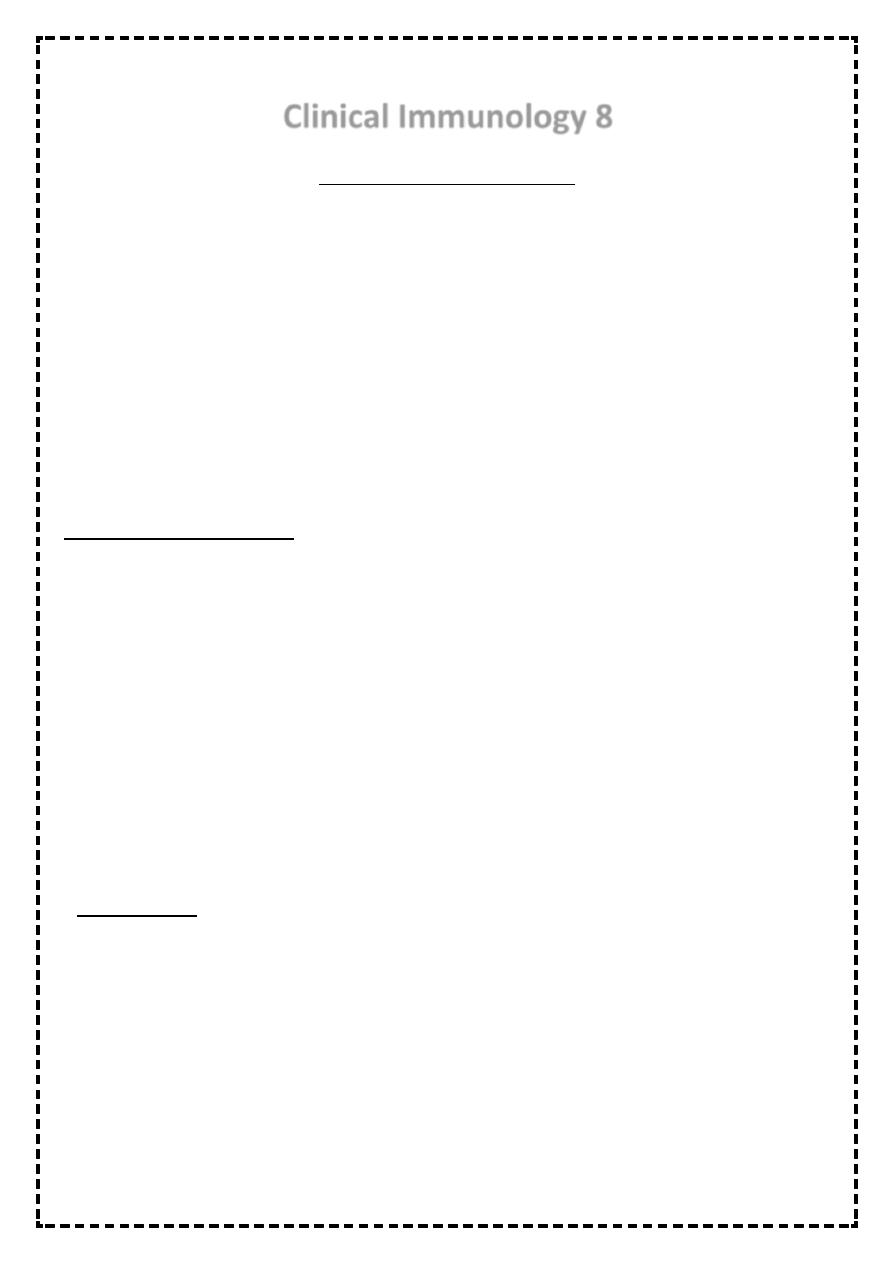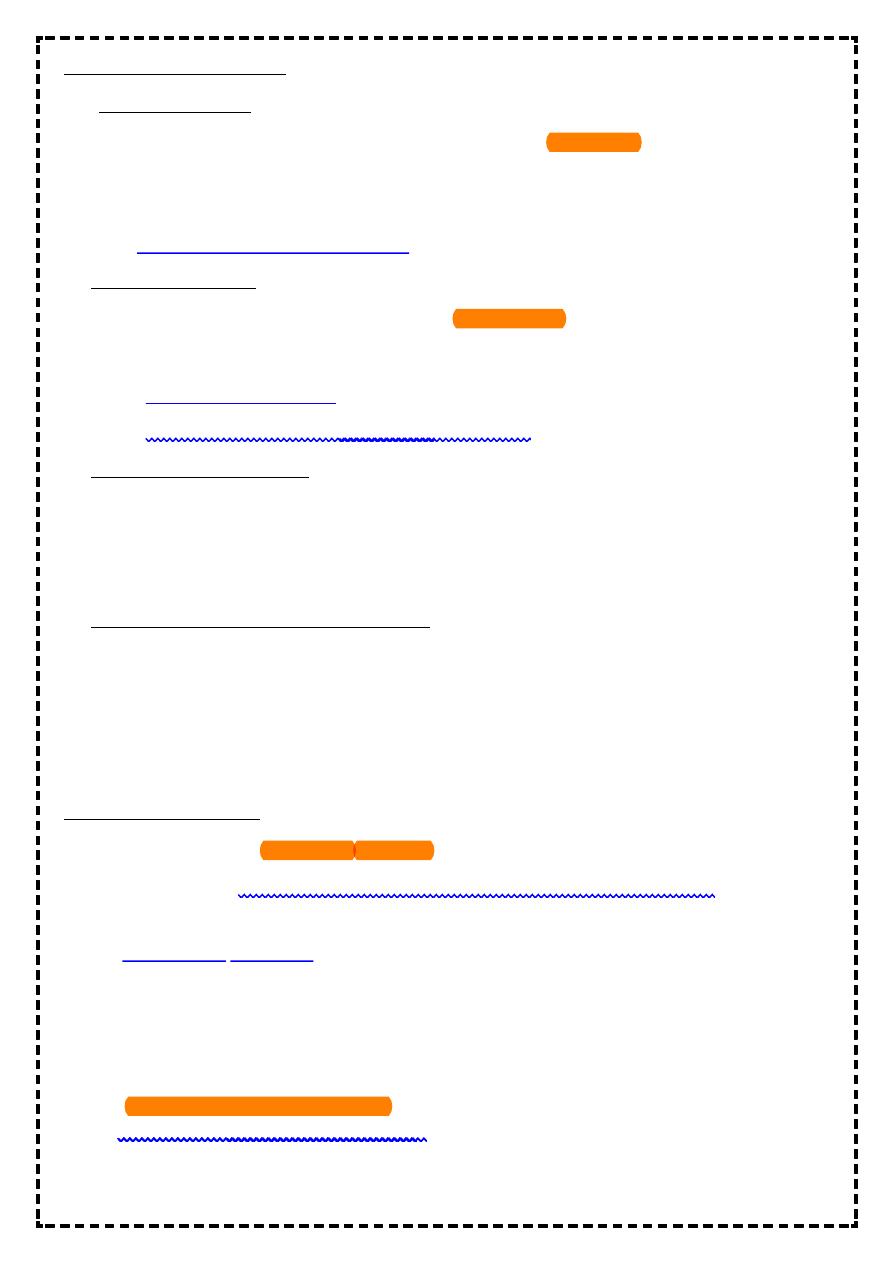
~1
~
Third Stage Internal Medicine Dr. Fadhil
Clinical Immunology 8
Organ Transplantation
• Transplantation refers to the act of transferring cells, tissues, or organs from one site to
another.
• Or is the process of taking cells, tissues, or organs, called a graft, from one individual and
placing them into a different individual.
individual who provides the graft:
donor
individual who receive the graft:
recipient
Transplanted organs\tissues
• -liver
• -kidney
• -pancreas
• -heart
• -lung
• -intestine
• -face
• -bone marrow
• -cornea
Types of donor
• _living
• The donor remains a live and donates a renewable tissue, cell, or fluid( e.g. blood, skin),
or donates an organ or part of an organ in which the remaining organ can regenerate or
take on the workload of the rest of the organ (primarily single kidney donation, partial
donation of the liver)
• --deceased(formerly cadaveric)
• Are donors who have been declared brain-dead and whose organs are kept viable by
ventilators or other mechanical mechanisms until they can be excised for transplantation.

~2
~
Types of transplant
• *autograft is self-tissue transferred from one body site to another in the same individual
• *isograft is tissue transferred between genetically identical individuals
• *allograft is tissue transferred between genetically different members of the same
species
• *xenograft is tissue transferred between different species
Pre-transplantation evaluation
• -blood type ( A,B, AB and O)
• -human leukocyte antigens( HLA) tissue typing
• -serology; for HIV, CMV and hepatitis
• - cardiopulmonary, cancer screening
HLA tissue typing
• - matching of stem cell donor to a recipient is determined by comparing their tissue types
• - an individual’s HLA type is present on nearly all tissues in the body
• - the white cells from a blood sample are a convenient source of ‘tissue’ that the
laboratory can use to determine an individual’s HLA type.
Why is HLA typing important?
• -because the degree of HLA compatibility between donor and recipient will influence the
outcome of transplant.
• -the function of the immune system is to fight against foreign particles such as bacteria
and viruses.
• A stem cell transplant from an HLA mismatched donor can result in recipient's immune
system recognizing the transplanted cells as( non selfing) and attacking the cells as it
would for bacteria or viruses. This can lead to rejection of the transplanted stem cells
• Likewise cells from the donor’s immune system which are introduced along with the
transplanted stem cells ‘graft’ can also recognize HLA mismatches and attack vital organs
of the recipient ‘s body ‘host’. This is also called graft versus host disease ( GvHD).
• -the more compatible the donor- recipient match, the less likely it is that rejection or
severe GvHD will occur.
How is HLA typing performed?
• - a 20-30 ml blood sample is required to perform HLA typing. The white cells are isolated
from the blood and typing is performed by two different methods:
• 1- serological testing: where the white cells are used

~3
~
• 2- DNA testing : where DNA extracted from the white cells is used.
• Preliminary tissue typing takes about 2 weeks. Further high resolution (more detailed)
tissue typing performed on the patient and any potentially matched donor samples may
take another 2-4 weeks.
Searching for a related donor
• - an HLA type consist of two main groups:
• Class I antigens ( HLA-A,-B, -C) and class II antigens ( HLA- DR, -DQ, DP)
• - there are six antigens considered most important for determing compatibility: two A
antigens, and two DR antigens, and two B antigens.
• -we inherit a set (or haplotype) of HLA-A, B, and DR antigens from each parent.
• HLA antigens corresponding to MHC class I ( A,B &C) present peptides from inside the cell
(including viral peptide if present)
• - HLA antigens corresponding to MHC class II (DP,DQ & DR) present antigens from out
side of the cell to T –lymphocytes.
• -HLA typing of potential donors and a recipient can be accomplished with a
microcytotoxisity test.
Immunology of transplant rejection
• Component of the immune system involved in graft rejection
• 1- antigen presenting cells:
• -dendritic cells
• - macrophage
• -activated B cells
• 2- B cells and antibodies
• 3- T cells
• 4- other cells
• - natural killer cells
• - monocytes
The immunology of allogeneic transplantation
• - recognition of transplanted cells that are self or foreign is determined by polymorphic
genes (MHC) that are inherited from both parents and are expressed co-dominantly.
• - alloantigens elicit both cell- mediated and humeral immune responses.

~4
~
Recognition of alloantigens
Direct presentation
• - recognition of an intact MHC molecule displayed by donor APC in the graft
• -basically, self MHC molecule recognizes the structure of intact allogeneic MHC
molecule
• - involves both CD8 and CD4 T cells
Indirect presentation
• -donor MHC is processed& presented by recipient APC
• - basically, donor MHC molecule is handled like any other foreign antigen
• - involve only CD4 T cells
• - antigen presentation by class II MHC molecules.
Role of CD4 and CD8 T cells
• -CD4 differentiate into cytokine producing effector cells
• *damage graft by reactions
• -CD8 cells activated by direct pathway kill nucleated cells in the graft
Effector mechanisms of allograft rejection
• -hyperacute rejection
• -acute rejection
• - chronic rejection
Hyperacute rejection
• -characterized by thrombotic occlusion of the graft
• -begins within minutes or hours after hosts blood vessels are anastomosed to graft
vessels
• -pre- existing antibodies in the host circulation bind to donor endothelial antigens
• -activates complement cascade.
Acute rejection
• -vascular and parenchymal injury mediated by T cells and antibodies that usually begin
after the first week of transplantation
• -incidence is high (30%) for the first 90 days.

~5
~
Chronic rejection
• -occurs in most solid organ transplant
• *heart
• * kidney
• * lung
• *liver
• - characterized by fibrosis and vascular abnormalities with loss of graft function over a
prolonged period.
TRANSPLANTATION & GRAFT REJECTION
• Transplantation provides the opportunity for definitive treatment of end organ disease.
• The complications after transplantation depend on:
• 1-the organ transplanted
• 2-the genetic disparity between recipient& donor
• 3-the primary disease &
• 4-drug therapy used
• The major complications are GRAFT REJECTION& INFECTION.
• The difference between the recipient & donor HLA proteins, the nature of transplanted
tissue& the immune status of the recipient determine the nature & severity of rejection.
• Histological analysis of rejected organs shows a range of immunological processes in
action. With modern tissue-matching approaches, hyper acute rejection is rare & acute
rejection can usually be prevented or treated with immunosuppression.
• As a consequence of the vigorous immunosuppression required to avoid allograft
rejection, secondary immunodeficiency often arises in graft recipients, manifesting as
infections & malignancies.
• Cytomegalovirus is particularly common, along with herpes viruses, fungal
organisms(aspergillus & Nocardia spp., cryptococcal infection), mycobacteria& parasites
(pneumocystis, toxoplasma spp.).
• The most common cancers seen after organ transplantations are lymphoma, skin cancers
& Kaposi's sarcoma.

~6
~
Liver transplantation
• The outcome fallowing liver transplantation has improved over the past decades, but the
number of the procedures is limited by cadaver donor availability. This limitation had
partially solved by development of living donor liver transplantation.
• The main complication of liver transplantation is related to disease recurrence in the liver
graft.
• 10% of LT is performed for acute liver failure
• 6% for metabolic diseases
• 70% for liver cirrhosis
• 11% for hepatocellular carcinoma
Contraindications to Liver Transplantation
• a-sepsis
• b-extra hepatic cancers
• c-cardio respiratory dysfunction
• d-active alcohol intake.
• Patients candidate for liver transplantation are ABO &size matched but not HLA –
matched with donor.
• Less immunosuppression is noted following LT than with kidney & heart –lung
transplantation.
• Acute rejection: occurs in up to 60% of cases, usually within first 6 weeks after
transplantation & responds to 3 days course of high dose of methylprednisolone.
• Chronic vascular rejection is rare &occurs in only 5% of cases.
Graft versus host disease(GVHD)
• This type of rejection is due to cytotoxic activity of donor T-lymphocytes in patients with
bone marrow transplantation which become sensitized to there new host regarding it as
a foreign.
• Acute GVHD: occurs in first 100 days fallowing transplantation in 1/3 of patients. It can
affect skin causing rashes, liver causing jaundice & the gut causing diarrhea.
• Prevention includes HLA matching of the donor & immunosuppressive drugs including
methotrexate , cyclosporine & anti-thymocyte globulin. The more sever forms prove fatal
in spite of high dose steroids.

~7
~
Chronic GVHD
• This may fallow acute GVHD or arise independently & occurs later than acute GVHD.
• It often presents similar to connective tissue disease, although in mild forms, skin rash is
the only manifestation.
• Chronic GVHD is treated with corticosteroids &prolonged use of immunosuppressive
agents like cyclosporine.
• Graft versus leukemia effect often fallow chronic GVHD & this is beneficial in terms of
reduction of relapse rate fallowing bone marrow transplantation.
Best Wishes & Good Luck
